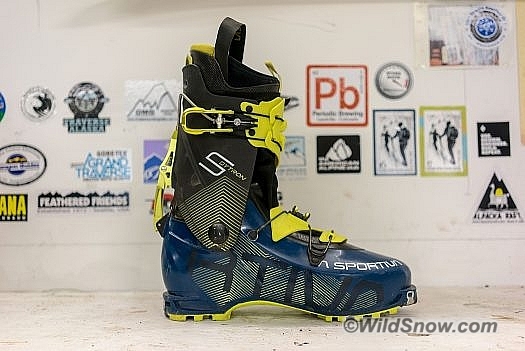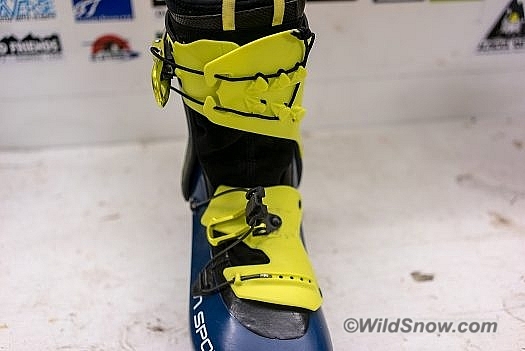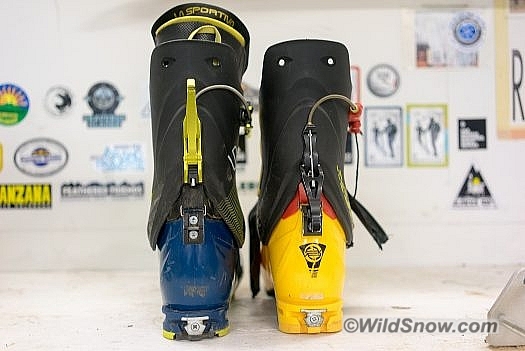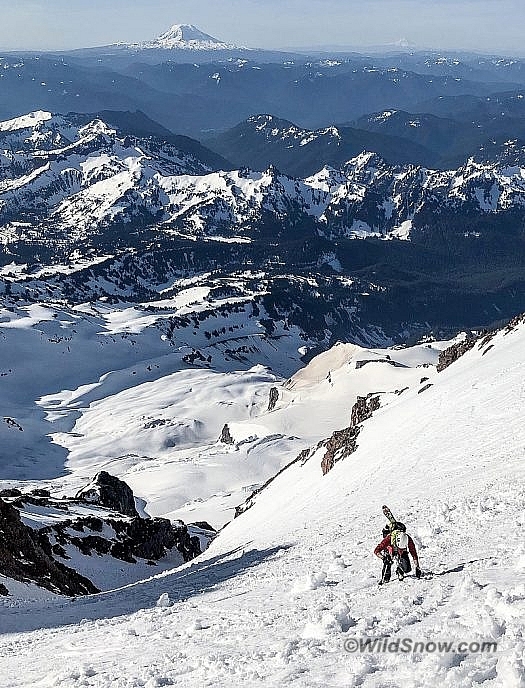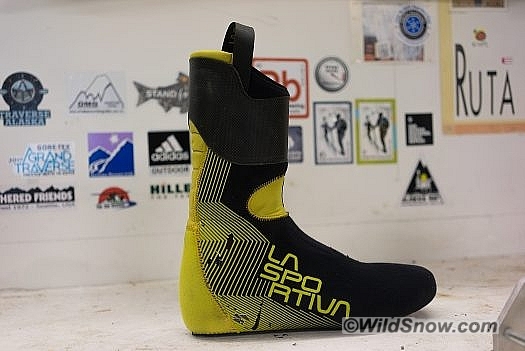Not so long ago, the backcountry boot game involved a simple equation: tally the level gnar of you wanted to ski on a scale from 2 to 4 and correlate each gnar point to the number of buckles on your ski boot. If you wanted to rip spines in Alaska, you bought a 4-buckle boot and added a power strap. If you wanted to do Lycra laps in an up-down race, you bought a 2-buckle boot and removed unnecessary pieces (I am embarrassed to say I once unscrewed the logo on a pair of race boots to save weight. Boot gnar level 1/2!).
There is an obvious problem with this equation — no matter what sort of ski tourer you are, most of your day is spent going uphill and yet you don’t want to ski down in sneakers. This has led boot makers to both try and shed weight from (and add mobility to) the burlier end of their line, and add stiffness and durability to their lighter boots. The La Sportiva Sytron is a prime example of the latter: a ski-mo race style boot with backcountry capabilities. (Also see WildSnow’s review of the women’s Sytron.)
Last week I had a chance to take the Sytron up and down some PNW volcanoes. They were oh-so-quick on the up and held there own just fine on the down. Here is my initial take after about 30k vert in corn and spring hot-pow.

I guess gear testing can be fun. Yours truly heading through the ‘Hot Rocks’ on Mount Hood. Photo by Andy Mention
I am a 175 lbs skier who used the Sytron with 178 BD Helio 88s mounted with Dynafit Speed Turn bindings — this set up is likely at the bigger end of the Sytrons wheelhouse. The 27.5 weighs in at 987g per boot (a bit heavier than advertised by Sportiva, but still ultra light). A full 75 degree range of motion makes the Sytron’s walk mode as good as a full on skimo race boot. A little bit of extra weight and carbon reinforced cuff (to an otherwise Grilamid shell) gives it the boost needed for fast and light mountain travel as well. The Sytron takes the basic blueprint and function of a ski-mo slipper and sticks it in a design that feels adept as both a fitness machine and mountain boot.
I have had a pair of La Sportiva Syborgs for the past few years and think they are an excellent race boot. Like Dynafit PDGs and Scarpa Aliens, they show up on big mountains now and then, but are more running shoe than backcountry boot. After finding myself without a light touring boot this spring, I jumped at the chance to slip on the Sytron. It shares the best parts of the Syborg but also solves many of the problems that made the Syborg a race boot and not a real ski mountaineering boot. The Sytron adds durability through updates to the Syborg ski/walk bar, boot gaiter, lower shell design, lower buckle, and liner, but keeps the scales light. It is the first boot I have skied that really feels like a race boot on the up, but more than that on the down.
The Sytron drives my 88s just fine, and really excels on my 76s (though I haven’t has as much time yet with them on the smaller set up). I have pushed through the boot a bit making big arcs in fast corn, but so long as I am willing to trade GS turns for more reasonable wiggling at lower speeds, the 88 is well within the Sytron comfort zone.
The boot’s upper buckle is the Sportiva race boot setup — essentially a shoelace — it is light and effective. This p-chord strap doesn’t inspire confidence, but I have had no issues with it in the field. I particularly appreciate the ‘CavoBike Lever’. This upper buckle makes the switch from ski to walk mode in one motion and keeps the ski-walk bar out of the way of snow, rocks, and crampons by flipping the ski-walk bar 180 degrees up (see picture below). The Syborg had a smaller bar oriented down (and the Spitfire 2.0 with a bar oriented up). This simple change makes the Sytron more crampon compatible, easier to boot off-piste with, and more trustworthy in my book.
The boot’s lower buckle (what Sprotiva calls the “Spyder Buckle Evo”) is a well placed two-in-one with both loose and tight levers that sits atop a z-shaped forefoot plastic overlap (the black and yellow levers in pic 4). The loose lever is excellent for touring, while the tight lever is easy to flip for the down. This new lower buckle adds significantly to the boots performance by supporting a large swath of the lower boot.
Like many skiers out there, I have a hard time finding boots that are kind to my hobbit feet. My first day on unmolded out of the box Sytrons was a 7,500 foot lap on Mount Rainier – no blisters and happy feet blew my mind.
A built in gaiter improves on the zippered cuff that broke on anyone who had more than 20 days on their Syborgs. While it could be a bit higher, it is effective when matched with the stock liner, which come with a reinforced water resistant upper cuff.
The Sytron’s performance outmatches other boots I have skied in the sub 1-kilo weight class. However, three small issues jump out. First, I wish the liners were a bit lighter, as the incredibly burly Palau liner feels like a bit of a mismatch with the rest of the boot (Andy spent some of our volcano tour with Syborg liners in the Sytron shell). Secondly, the Sytron is hard to get on or off without removing the liner. This is just plain annoying. Third, a heel insert in the shell came unglued after my first day. This also happened in my Syborgs, and since the Sytron heel piece has ‘Syborg’ printed on it, it’s fair to say it’s the exact same insert with the same issue (easy to fix, but also could be easily avoided by La Sportiva with better glue).
Note Sytron boasts the Sportiva S4 tech insert at the toe. These ostensibly make it easier to clip in. They don’t hurt anything except for creating a small area where your boot sole is steel instead of rubber. If you do a lot of dirt hiking or rock scrambling, something to consider. Otherwise, probably non-issue.
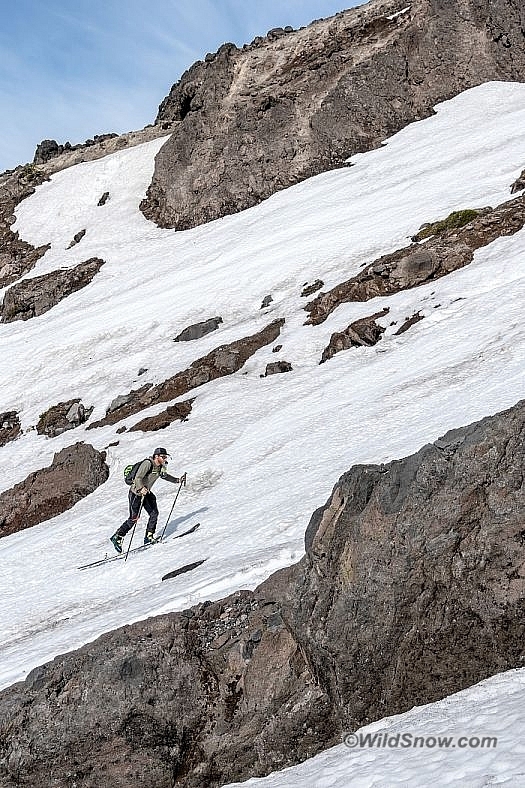
Yours truly enjoying happy feet and a light kit – a sub-kilo boot sure makes big days hurt less. Photo by Andy Mention.
The past few years have seen a number of creative moves in skimo race boots, spurred at least in part by the increase in uphill fitness skiers. It is exciting to see that innovation breed gear that is also mountain ready. After some more spring skiing and maybe a bit of fall pow, I will offer up a more extensive review. Granted I am a card-carrying member of the ‘light is right’ crowd, but my first impressions of the Sytron are strong.
Dr. Alex Lee lives in Anchorage, Alaska. Alex is a professor at Alaska Pacific University, teaching philosophy and environmental studies. He also works as a sometimes guide, naturalist, writer, and photographer.

